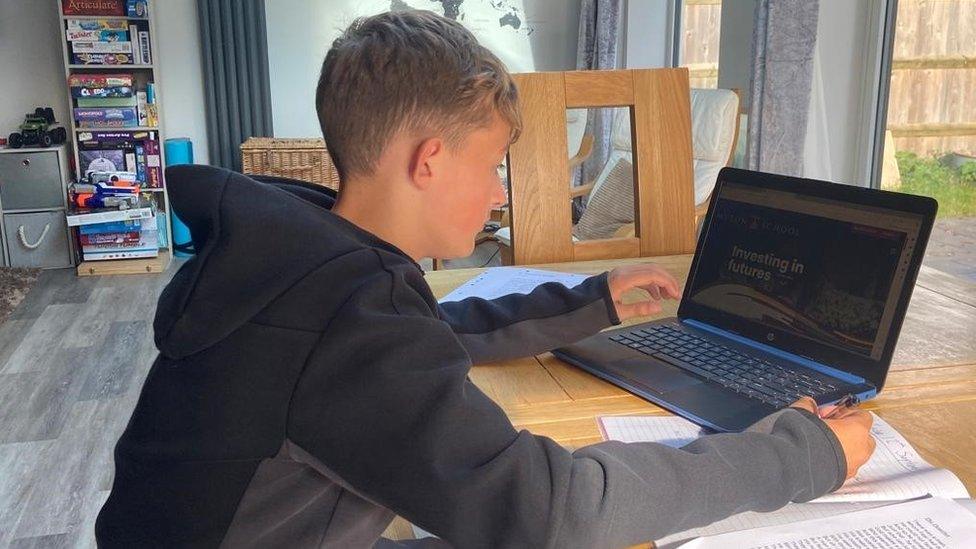Government to update list of Raac-affected schools in England
- Published

Elliot, from Myton School in Warwick, is receiving a mix of face-to-face and remote learning because of Raac
The government is expected to issue an update to its official list of schools in England with reinforced autoclaved aerated concrete (Raac) on Tuesday.
MPs will also question the Department for Education (DfE) on the disruption affecting schools and colleges.
Officials have said they are checking hundreds of schools every week and, as of 30 August, 147 schools in England were known to be affected.
One parent with a son at an affected school said they feel abandoned.
Fay Arrundale's son Elliot attends Myton School in Warwick, but the secondary school had to close some of its buildings because of Raac and is now having different year groups attending in alternate weeks.
Elliot is one of more than 22,000 pupils in England who are receiving a mix of face-to-face and remote learning because of Raac.
Fay, who is self-employed and having to juggle her work schedule around the changes, says Elliot can become distracted when having online learning and that he "needs the structure of school".
She says the school have been "fantastic" but there is no timescale on when things will return to normal, as any progress on getting portable classrooms is "really slow".
"It is like Covid all over again," explains Fay, "but it's harder as that time, the world was going through the same thing, but this feels like we have been abandoned."
Myton School's two main buildings were built in the 1950s or 1960s and are "old and in disrepair", so the head teacher applied for extra cash from the government's school rebuilding programme.
But a letter from the DfE, seen by BBC News, rejected the application because other schools were in worse condition.
Raac is a lightweight material that was used mostly in flat roofing, but also in floors and walls, between the 1950s and 1990s. It is a cheaper alternative to standard concrete and has a lifespan of about 30 years.
Just days before the start of the autumn term, the DfE updated its guidance so that schools with Raac, which was previously deemed safe, were told to close any areas containing the concrete without safety measures in place.

Officials have said they are checking hundreds of schools every week for Raac
Association of School and College Leaders general secretary Geoff Barton welcomed an updated list but accused the government of being on the back foot.
Some schools were still dealing with "huge logistical issues" and "we haven't got a timescale of when this will be sorted out", he said.
Susan Acland-Hood, a permanent secretary at the DfE, and Education Minister Baroness Barran, who has responsibility for school capital investment, will appear before the Education Committee on Tuesday and are expected to provide an update on the situation.
Robin Walker, chairman of the Education Committee, said its members have heard "loudly and clearly the distress and anxiety that this crisis is causing to families and staff" at affected schools.
"We share the feeling of urgency to establish how this situation developed, how and when it can be resolved, and what lessons need to be learnt," he said.
'Flat out'
The DfE has previously defended its decision to change its guidance so close to the start of the term, saying it acted after three incidents during the summer.
Education Secretary Gillian Keegan said they have continued working "flat out" this week to minimise disruption to education and to keep children and staff safe.
In Scotland, schools in 16 local authorities have been found to contain Raac and surveys will be carried out at 120 schools across Northern Ireland to check for the concrete, the Education Authority has said.
Two schools have closed in Wales while checks are being carried out, and students in one other school are receiving a mixture of face-to-face and remote learning.
Additional reporting by Sallie George
- Published13 February 2024
